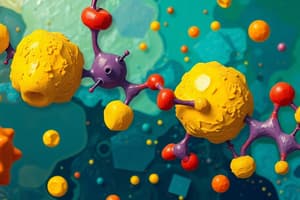Podcast
Questions and Answers
What is the basic empirical formula for carbohydrates?
What is the basic empirical formula for carbohydrates?
- Cm(H2O)n (correct)
- C2H2O2
- CnH4O2
- Cm(H2O)m
Which type of carbohydrate cannot be hydrolyzed into smaller carbohydrates?
Which type of carbohydrate cannot be hydrolyzed into smaller carbohydrates?
- Monosaccharides (correct)
- Polysaccharides
- Oligosaccharides
- Disaccharides
Which of the following is a common characteristic of monosaccharides?
Which of the following is a common characteristic of monosaccharides?
- They contain multiple sugar units.
- They are insoluble in water.
- They cannot form larger carbohydrates.
- They are colorless, crystalline solids. (correct)
What distinguishes aldoses from ketoses?
What distinguishes aldoses from ketoses?
Which of the following is a type of carbohydrate with two sugar units?
Which of the following is a type of carbohydrate with two sugar units?
Which of the following carbohydrates is known as a simple sugar?
Which of the following carbohydrates is known as a simple sugar?
Which of the following is NOT a classification of carbohydrates?
Which of the following is NOT a classification of carbohydrates?
What is the primary functional group found in aldoses?
What is the primary functional group found in aldoses?
What is the role of heparin in the body?
What is the role of heparin in the body?
Which carbohydrate is essential for providing cushioning in joints?
Which carbohydrate is essential for providing cushioning in joints?
Which of the following substances is NOT mentioned as a part of the carbohydrate classification?
Which of the following substances is NOT mentioned as a part of the carbohydrate classification?
What is one of the functions of carbohydrates mentioned in the content?
What is one of the functions of carbohydrates mentioned in the content?
What type of carbohydrates are cellulose and starch classified as?
What type of carbohydrates are cellulose and starch classified as?
Which GAG contains N-acetylgalactosamine as its amino sugar component?
Which GAG contains N-acetylgalactosamine as its amino sugar component?
What type of linkage connects the units in peptidoglycan?
What type of linkage connects the units in peptidoglycan?
Which polysaccharide is primarily responsible for mechanical stability in organisms?
Which polysaccharide is primarily responsible for mechanical stability in organisms?
Which of the following is NOT a storage polysaccharide?
Which of the following is NOT a storage polysaccharide?
Which GAG is specifically mentioned as being part of synovial fluid?
Which GAG is specifically mentioned as being part of synovial fluid?
What is the primary function of agarose in marine algae?
What is the primary function of agarose in marine algae?
Which amino sugar is found in keratan sulfate?
Which amino sugar is found in keratan sulfate?
What is the role of peptidoglycan in bacterial cells?
What is the role of peptidoglycan in bacterial cells?
What kind of bond is formed when the OH group on carbon-1 of glucose is above the ring plane?
What kind of bond is formed when the OH group on carbon-1 of glucose is above the ring plane?
Which disaccharide is composed of one D-galactose molecule and one D-glucose molecule?
Which disaccharide is composed of one D-galactose molecule and one D-glucose molecule?
Which of the following is a reducing sugar?
Which of the following is a reducing sugar?
What is the systematic name for sucrose?
What is the systematic name for sucrose?
Which disaccharide does not have a free hemiacetal unit?
Which disaccharide does not have a free hemiacetal unit?
How is maltose linked together at the molecular level?
How is maltose linked together at the molecular level?
Which of the following is the most abundant disaccharide?
Which of the following is the most abundant disaccharide?
What type of linkage is present in the disaccharide cellobiose?
What type of linkage is present in the disaccharide cellobiose?
What is the classification of monosaccharides based on the number of carbon atoms?
What is the classification of monosaccharides based on the number of carbon atoms?
Which of the following sugars is considered an aldohexose?
Which of the following sugars is considered an aldohexose?
In ring form, how does the hydroxyl group orientation at the anomeric carbon define the configuration of glucose?
In ring form, how does the hydroxyl group orientation at the anomeric carbon define the configuration of glucose?
What bond is formed between two monosaccharide units during the dehydration reaction?
What bond is formed between two monosaccharide units during the dehydration reaction?
Which of the following statements about glucose is correct?
Which of the following statements about glucose is correct?
What is the principal function of ribose in living organisms?
What is the principal function of ribose in living organisms?
What distinguishes glucose, galactose, and fructose despite having the same chemical formula C6H12O6?
What distinguishes glucose, galactose, and fructose despite having the same chemical formula C6H12O6?
What is the result of combining the hydroxyl group of one monosaccharide with the hydrogen of another?
What is the result of combining the hydroxyl group of one monosaccharide with the hydrogen of another?
Which oligosaccharide is specifically an energy source for insects?
Which oligosaccharide is specifically an energy source for insects?
What type of bond links monosaccharides in oligosaccharides?
What type of bond links monosaccharides in oligosaccharides?
Where do N-Linked oligosaccharides attach to proteins in eukaryotes?
Where do N-Linked oligosaccharides attach to proteins in eukaryotes?
What is the structural formula for a trisaccharide?
What is the structural formula for a trisaccharide?
In which cellular structure does O-Linked oligosaccharide attachment primarily occur?
In which cellular structure does O-Linked oligosaccharide attachment primarily occur?
Which function of glycoproteins is NOT mentioned in the content?
Which function of glycoproteins is NOT mentioned in the content?
Which statement about oligosaccharides is FALSE?
Which statement about oligosaccharides is FALSE?
What do lectins specifically bind to?
What do lectins specifically bind to?
Flashcards
Carbohydrates
Carbohydrates
Biomolecules containing a carbonyl group (aldehyde or ketone) and multiple hydroxyl groups, composed of carbon, hydrogen, and oxygen.
Monosaccharides
Monosaccharides
The simplest carbohydrates; single sugar units that cannot be broken down into smaller sugars.
Simple Sugars
Simple Sugars
A simpler name for Monosaccharides. They are colorless, crystalline solids soluble in water and insoluble in oil.
Aldoses
Aldoses
Signup and view all the flashcards
Ketoses
Ketoses
Signup and view all the flashcards
Empirical Formula of Monosaccharides
Empirical Formula of Monosaccharides
Signup and view all the flashcards
Glucose
Glucose
Signup and view all the flashcards
Classification of Carbohydrates
Classification of Carbohydrates
Signup and view all the flashcards
Glycosidic Bond
Glycosidic Bond
Signup and view all the flashcards
Alpha (α) Glycosidic Bond
Alpha (α) Glycosidic Bond
Signup and view all the flashcards
Beta (β) Glycosidic Bond
Beta (β) Glycosidic Bond
Signup and view all the flashcards
Disaccharide
Disaccharide
Signup and view all the flashcards
Reducing Sugar
Reducing Sugar
Signup and view all the flashcards
Non-reducing Sugar
Non-reducing Sugar
Signup and view all the flashcards
What are monosaccharides?
What are monosaccharides?
Signup and view all the flashcards
What is a glycosidic bond?
What is a glycosidic bond?
Signup and view all the flashcards
What are aldohexoses?
What are aldohexoses?
Signup and view all the flashcards
How do glucose, galactose, and fructose differ?
How do glucose, galactose, and fructose differ?
Signup and view all the flashcards
What are the two forms of glucose?
What are the two forms of glucose?
Signup and view all the flashcards
Why is glucose important?
Why is glucose important?
Signup and view all the flashcards
What about fructose?
What about fructose?
Signup and view all the flashcards
What is lactose?
What is lactose?
Signup and view all the flashcards
Oligosaccharide
Oligosaccharide
Signup and view all the flashcards
Glycolipid
Glycolipid
Signup and view all the flashcards
Glycoprotein
Glycoprotein
Signup and view all the flashcards
N-Linked Oligosaccharide
N-Linked Oligosaccharide
Signup and view all the flashcards
O-Linked Oligosaccharide
O-Linked Oligosaccharide
Signup and view all the flashcards
Functions of Glycoproteins
Functions of Glycoproteins
Signup and view all the flashcards
Functions of Glycolipids
Functions of Glycolipids
Signup and view all the flashcards
What are some common examples of carbohydrates in living organisms?
What are some common examples of carbohydrates in living organisms?
Signup and view all the flashcards
What makes carbohydrates important in development?
What makes carbohydrates important in development?
Signup and view all the flashcards
GAGs
GAGs
Signup and view all the flashcards
Hyaluronic acid
Hyaluronic acid
Signup and view all the flashcards
Chondroitin sulfate
Chondroitin sulfate
Signup and view all the flashcards
Heparan sulfate
Heparan sulfate
Signup and view all the flashcards
Heparin
Heparin
Signup and view all the flashcards
Dermatan sulfate
Dermatan sulfate
Signup and view all the flashcards
Keratan sulfate
Keratan sulfate
Signup and view all the flashcards
Peptidoglycan
Peptidoglycan
Signup and view all the flashcards
Study Notes
Introduction to Carbohydrates
- Carbohydrates are essential for all living things (plants, animals, microbes)
- Found in various foods (fruits, grains, vegetables, milk, honey)
- Were the last of the four macromolecules (proteins, fats, nucleic acids) to be studied in detail
What are Carbohydrates?
- Biomolecules containing a carbonyl group (aldehyde or ketone) and several hydroxyl groups
- Composed of carbon (C), hydrogen (H), and oxygen (O) atoms
- Typically have a 2:1 H:O ratio (like water)
- Represented by the empirical formula Cm(H₂O)n or (CH₂O)n
- Some, like uronic acids, don't perfectly fit this formula
- Others, such as formaldehyde and acetic acid, have similar groups but aren't classified as carbohydrates
Classification of Carbohydrates
- Monosaccharides: Simple sugars; cannot be hydrolyzed into smaller carbohydrates
- Examples: glucose, fructose, galactose
- Disaccharides: Two monosaccharides joined together
- Examples: sucrose, lactose, maltose
- Oligosaccharides: 3-10 monosaccharides joined together
- Examples: raffinose, stachyose:
- Polysaccharides: Many monosaccharides joined together
- Examples: starch, glycogen, cellulose
Monosaccharides
-
Building blocks of disaccharides and polysaccharides
-
Colorless, crystalline solids, soluble in water, insoluble in nonpolar solvents
-
General formula: Cn(H₂O)n or CnH₂nOn (e.g., n = 3 is the smallest)
-
Aldoses (aldehyde group) and ketoses (ketone group)
-
Most common: glucose (aldohexose)
-
Number of carbons determines the classification (triose, tetrose, pentose, hexose, heptose, etc.)
-
Glucose, galactose, and fructose have the same chemical formula (C₆H₁₂O₆) but differ structurally, due to different arrangements of functional groups around their asymmetric carbon atoms
Structure of Monosaccharides
- Exist as linear chains or ring forms, often in equilibrium
- Ring form: hydroxyl group on carbon-1 (anomeric carbon) can be above (beta) or below (alpha) the plane.
Functions of Monosaccharides
- Glucose: Important energy source for humans and plants
- Ribose: Structural element of nucleic acids and coenzymes
- Fructose: Adds sweetness to fruits and honey
Disaccharides
-
Formed via dehydration synthesis (condensation reaction)
-
Two monosaccharides linked by a covalent glycosidic bond
-
Glycosidic bond can be alpha or beta
- Examples:
- Sucrose: glucose + fructose
- Lactose: galactose + glucose
- Maltose: glucose + glucose
- Examples:
Oligosaccharides
- Varying numbers of simple sugars
- Can act as important recognition units attached to proteins or lipids.
Functions of Oligosaccharides
- Components of glycoproteins and glycolipids (surface molecules on cells) involved in cell-cell recognition, signaling, and other important functions
Polysaccharides
- Polymers composed of repeating monosaccharide units
- Classified as homopolysaccharides (one type of monomer) or heteropolysaccharides (two or more types of monomers)
- Examples of homopolysaccharides: starch, glycogen, cellulose, chitin
- Examples of heteropolysaccharides: glycosaminoglycans (GAGs), peptidoglycans
- Functions of polysaccharides:
- Storage: Starch (plants), glycogen (animals), storage
- Structural: Cellulose (plants), chitin (exoskeletons)
Functions of Polysaccharides
- Structural: Provide support to tissues and cells (e.g., cellulose)
- Storage: Store energy for later use (e.g., glycogen, starch)
- Other roles: Part of other molecules, such as glycoproteins and glycolipids.
Additional Notes
- Carbohydrates are essential for energy, structure, and several other roles in living organisms.
- Variations in their structure and linkages influence their properties.
Studying That Suits You
Use AI to generate personalized quizzes and flashcards to suit your learning preferences.




